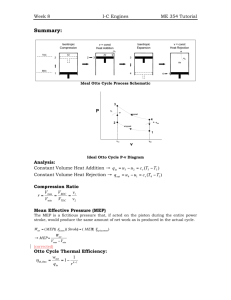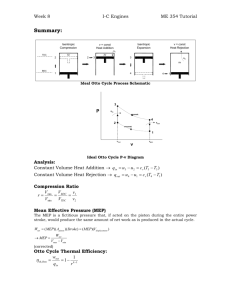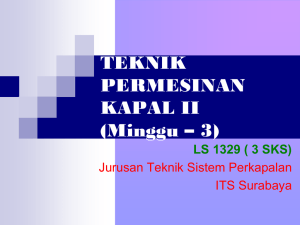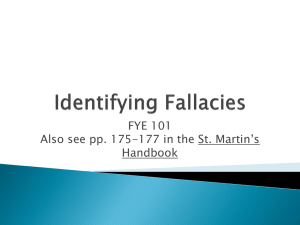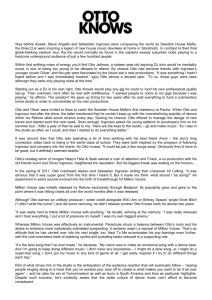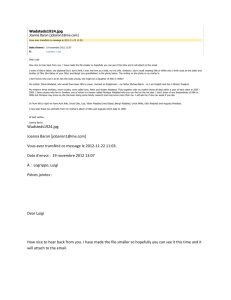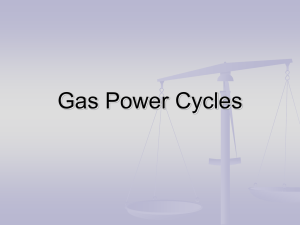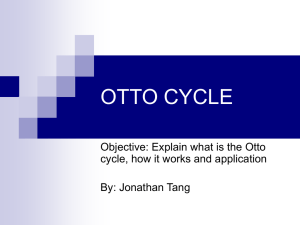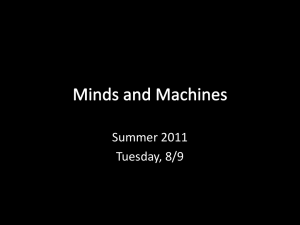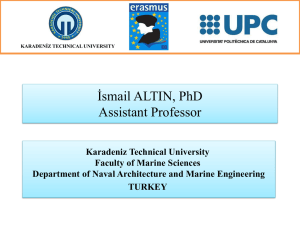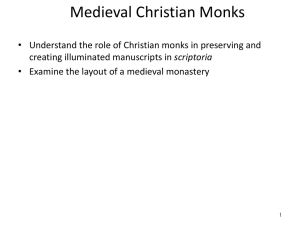Otto Cycle, ideal for spark ignition engines
advertisement
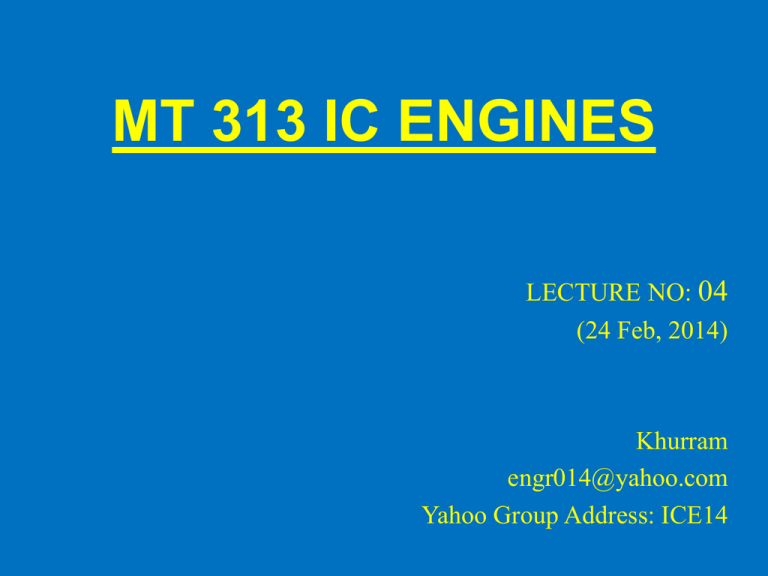
MT 313 IC ENGINES LECTURE NO: 04 (24 Feb, 2014) Khurram engr014@yahoo.com Yahoo Group Address: ICE14 Air Standard Cycle • The air as the working fluid follows the perfect gas law 𝑝𝑉 = 𝑚𝑅𝑇 • The working fluid is homogeneous throughout and no chemical reaction takes place • Specific heats of air do not vary with temperature • The mass of air in the cycle remains fixed • The exhaust process is replaced by an equivalent heat rejection process • The combustion process is replaced by an equivalent heat addition process • All processes are internally reversible Air Standard Cycle • Thermal efficiency 𝑊𝑜𝑟𝑘 𝐷𝑜𝑛𝑒 η𝑡ℎ = 𝐻𝑒𝑎𝑡 𝑆𝑢𝑝𝑝𝑙𝑖𝑒𝑑 𝐻𝑒𝑎𝑡 𝑆𝑢𝑝𝑝𝑙𝑖𝑒𝑑 − 𝐻𝑒𝑎𝑡 𝑅𝑒𝑗𝑒𝑐𝑡𝑒𝑑 = 𝐻𝑒𝑎𝑡 𝑆𝑢𝑝𝑝𝑙𝑖𝑒𝑑 𝑄𝑠 − 𝑄𝑟 = 𝑄𝑠 𝑞𝑠 − 𝑞𝑟 = 𝑞𝑠 • Thermal efficiency is also called air standard efficiency ηa Important Formulas • Swept Volume 𝜋 2 𝑉𝑠 = 𝑑 𝐿 4 • Clearance Volume 𝑉 = 𝑉𝑐 + 𝑉𝑠 • Compression Ratio 𝑉𝑐 + 𝑉𝑠 𝑟= 𝑉𝑐 • Clearance ratio 𝑉𝑐 𝑐= 𝑉𝑠 Ideal cycles are simplified Otto Cycle, ideal for spark ignition engines OTTO CYCLE • Process No 1-2 – Isentropic Expansion 1 pVγ = c P1 2 P2 γ= 𝑐𝑝 𝑐𝑣 V1 V2 p– V diagram • OTTO CYCLE Process No 1-2 – Reversible Adiabatic or Isentropic Expansion 1 T1 T2 2 T – S diagram No Heat is added or rejected Q 1-2 = 0 S1, S2 OTTO CYCLE • Process No 2-3 – Constant volume cooling process 2 P2 P3 3 V2 p– V diagram Heat is rejected by air getting cooled from T2 to T3 • OTTO CYCLE Process No 2-3 – Constant volume cooling process T2 2 T3 S3 , S4 T – S diagram S1, S2 Heat is rejected by air getting cooled from T2 to T3 OTTO CYCLE • Process No 3-4 – Isentropic Compression 4 pVγ = c P4 P3 γ= 𝑐𝑝 𝑐𝑣 3 V4 p– V diagram No heat is added or rejected V3 OTTO CYCLE • Process No 3-4 – Reversible Adiabatic or Isentropic Expansion T4 4 T3 3 S3 , S4 T – S diagram No Heat is added or rejected Q 3-4 = 0 OTTO CYCLE • Process No 4-1 – Constant volume heating process 1 P1 P4 4 V2 p– V diagram Heat is absorbed by air getting heated from T4 to T1 • OTTO CYCLE Process No 4-1 – Constant volume heating process 1 T1 T4 4 S3 , S4 S1, S2 T – S diagram Heat is absorbed by air getting heated from T4 to T1 OTTO Cycle • Process 1-2 No heat is added or rejected 𝑄1−2 = 0 • Process 2-3 Heat is rejected by air getting cooled from temperature T2 to T3 𝑄1−2 = 𝑚𝑐𝑣 𝑇2 − 𝑇3 • Process 3-4 No heat is added or rejected 𝑄3−4 = 0 • Process 4-1 Heat is absorbed by air getting heated from temperature T4 to T1 𝑄4−1 = 𝑚𝑐𝑣 𝑇1 − 𝑇4 OTTO Cycle • Work Done = Heat absorbed – Heat rejected • Work Done = 𝑄4−1 − 𝑄1−2 • Work Done = 𝑚𝑐𝑣 𝑇1 − 𝑇4 - 𝑚𝑐𝑣 𝑇2 − 𝑇3 •η= •η= 𝑊𝑜𝑟𝑘 𝐷𝑜𝑛𝑒 𝐻𝑒𝑎𝑡 𝐴𝑏𝑠𝑜𝑟𝑏𝑒𝑑 𝑚𝑐𝑣 𝑇1 −𝑇4 − 𝑚𝑐𝑣 𝑇2 −𝑇3 𝑚𝑐𝑣 𝑇1 −𝑇4 OTTO Cycle •η= 𝑚𝑐𝑣 𝑇1 −𝑇4 − 𝑚𝑐𝑣 𝑇2 −𝑇3 𝑚𝑐𝑣 𝑇1 −𝑇4 • η=1− • η=1− • η=1− 𝑚𝑐𝑣 𝑚𝑐𝑣 𝑇2 −𝑇3 𝑇1 −𝑇4 𝑇2 −𝑇3 𝑇1 −𝑇4 𝑇2 𝑇3 𝑇3 𝑇1 𝑇4 𝑇4 −1 −1 OTTO Cycle • For reversible adiabatic expansion process 1-2 • 𝑇2 𝑇1 = 𝑣1 γ−1 [ ] 𝑣2 • where expansion ratio = 𝑣2 𝑣1 OTTO Cycle • For reversible adiabatic expansion process 3-4 • 𝑇3 𝑇4 = 𝑣4 γ−1 [ ] 𝑣3 • where expansion ratio = 𝑣3 𝑣4 • 𝑣3 𝑣4 = OTTO Cycle 𝑣2 𝑣1 • η=1− • η=1 − • η=1− 𝑇3 𝑇4 𝑇2 𝑇1 1 𝑟 γ−1 OTTO CYCLE • Process No 1-2 – Isentropic Expansion 1 pVγ = c P1 2 P2 γ= 𝑐𝑝 𝑐𝑣 V1 V2 p– V diagram OTTO Cycle 2 𝑝𝑑𝑉 1 • 𝑊1−2 = • 𝑝𝑉 γ = 𝐶𝑜𝑛𝑠𝑡𝑎𝑛𝑡 • 𝑊1−2 = 𝐶 • 𝑊1−2 = • 𝑊1−2 = 2 𝑑𝑉 1 𝑉γ 𝑝1 𝑉1 −𝑝2 𝑉2 γ−1 𝑅 (𝑇1 −𝑇2 ) γ−1 Problem 1 • Calculate the air standard efficiency of a four stock Otto cycle engine with the following data Piston diameter (bore)= 13.7 cm Length of stock = 13.0 cm Clearance volume = 14.6 % • Diagram Solution • Swept Volume • 𝑉𝑠 = • = 𝜋 4 𝜋 4 𝐷2𝐿 13.72 ∗ 13 • = 1916 cm • Clearance Volume • 𝑉𝑐 = • 𝜋 4 ∗ 𝑉𝑠 = 297.7 cm3 Solution • Compression ratio • 𝑟𝑐 = 𝑉𝑠 +𝑉𝑐 𝑉𝑐 • = 7.85 • Air Standard efficiency • η=1− • 1 𝑟 γ−1 = 56.2% Problem 2 • In an Otto cycle the compression ratio is 6 . The initial pressure and temperature of the air are 1 bar and 100˚C. the maximum pressure in the cycle is 35 bar. Calculate the parameter at the salient points of the cycle. What is the ratio of heat supplied to heat rejected • How does air standard efficiency of the cycle compares with that of a Carnot cycle working within the same extreme temperature limits? Explain the difference between the two values Problem 2 • If the engine has a relative efficiency of 50 % determine the fuel consumption per kWh. Assume the fuel used has a calorific value of 42,000 kJ/kg Problem 3 • An Otto cycle working on air has a compression ratio of 6 and starting condition are 40˚C and 1 bar. The peak pressure is 50 bar. Draw the cycle on p-v and T-S coordinates if compression and expansion follow the law pV1.25 = C. Calculate mean effective pressure and heat added per kg of air. Problem 4 • An Otto cycle has compression ratio of 8 and initial conditions are 1 bar and 15˚C. Heat added during constant volume process is 1045 kJ/kg. Find : • Maximum cycle temperature • Air standard efficiency • Work done per kg of air • Heat rejected • Take cv = 0.7175 kJ/kg-K and γ = 1.4 Problem 5 • Find out the compression ratio in an Otto for maximum work output • An Otto cycle engine has the following data. Calculate compression ratio, air standard efficiency and specific fuel consumption. Piston diameter = 13.7 Length of stock = 13 cm Clearance volume = 280 cm3 Relative efficiency = 60 % Lower calorific volume of petrol = 41900kJ/kg
